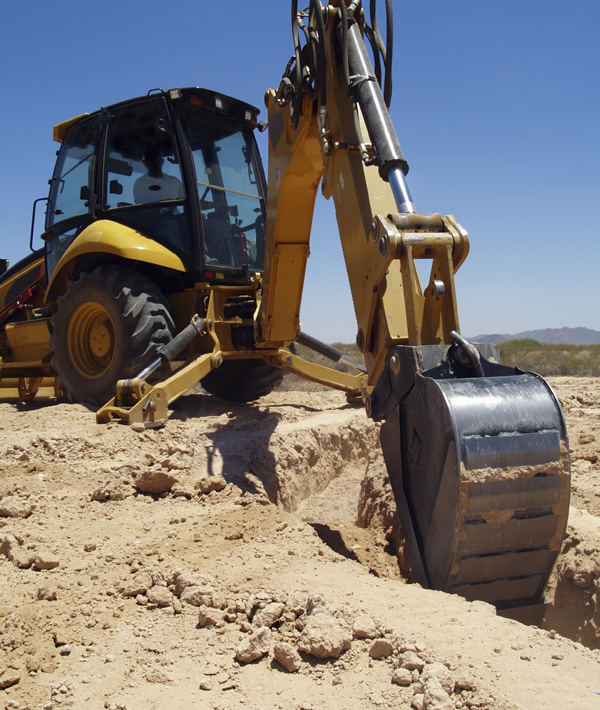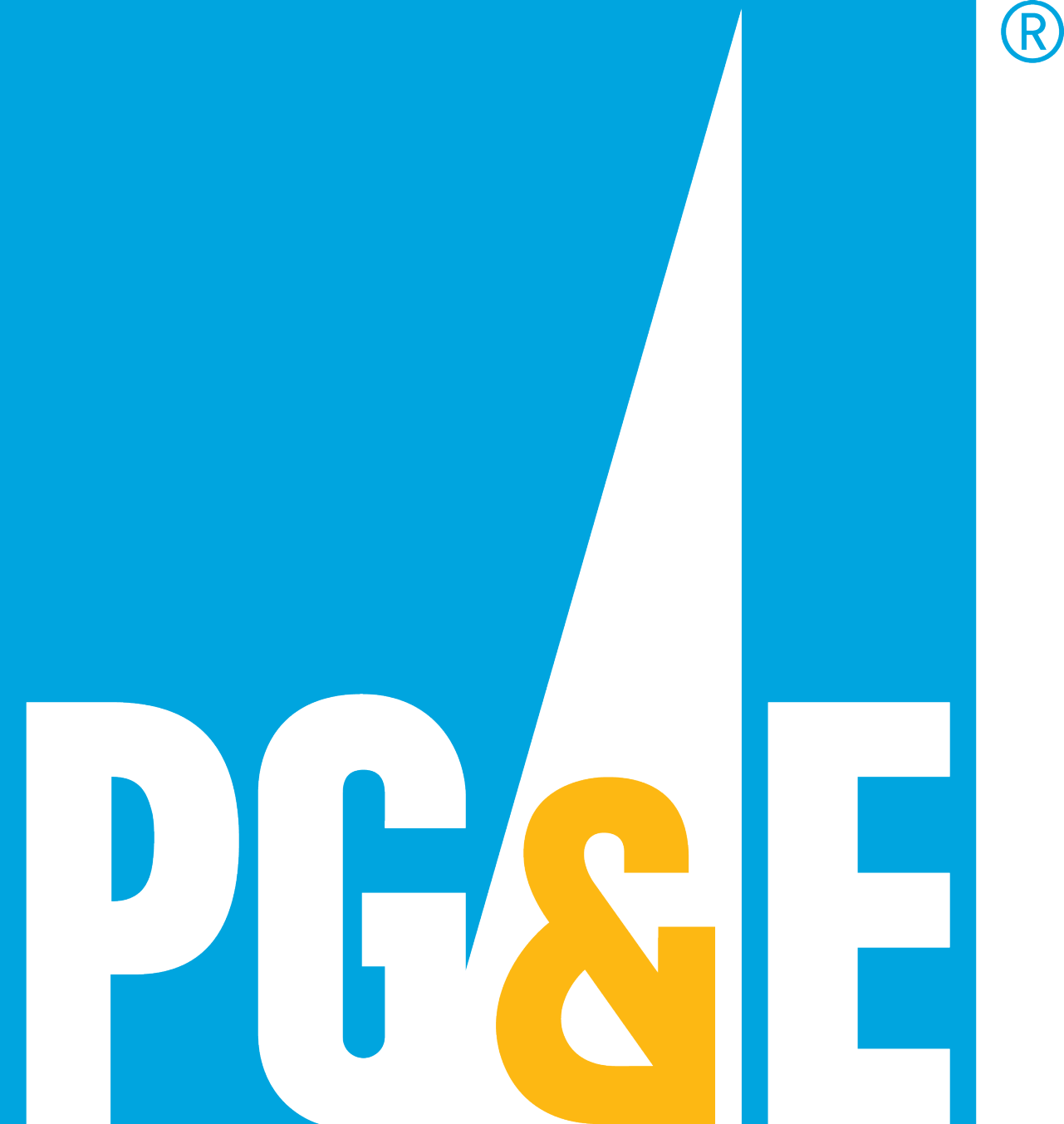Dig safely and prevent utility dig-ins
Utility contacts can be costly—and deadly. Underground utility contacts cost utility owners and contractors millions of dollars in repairs and service disruptions every year. Not only that, workers who contact buried utilities put themselves and the public at risk of injury or death. It’s your responsibility to dig safely to protect yourself, your crew, and the public.
Notify 811 before you dig or move earth in any way. This free service will arrange for PG&E and other 811 member utilities to locate and mark their underground lines so you can dig a safe distance away from them.
Dial 811 or use the online ticket-entry system, then wait your state’s required time for facility owners to mark their lines before you dig:
- California: Wait two full working days (not including the date of your request, weekends, and legal holidays).
Pre-mark your proposed excavation area with white paint, flags, and/or stakes before you contact 811.
Wait for utilities to be marked before digging. Once utilities are marked, respect the marks, hand expose to verify location, and dig with care.
Always contact your state 811 center before digging and for the most current requirements.
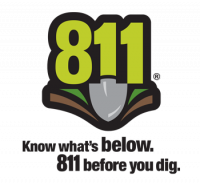 Notify 811 well ahead of digging so that underground utilities can be marked and you can work safely.
Notify 811 well ahead of digging so that underground utilities can be marked and you can work safely.
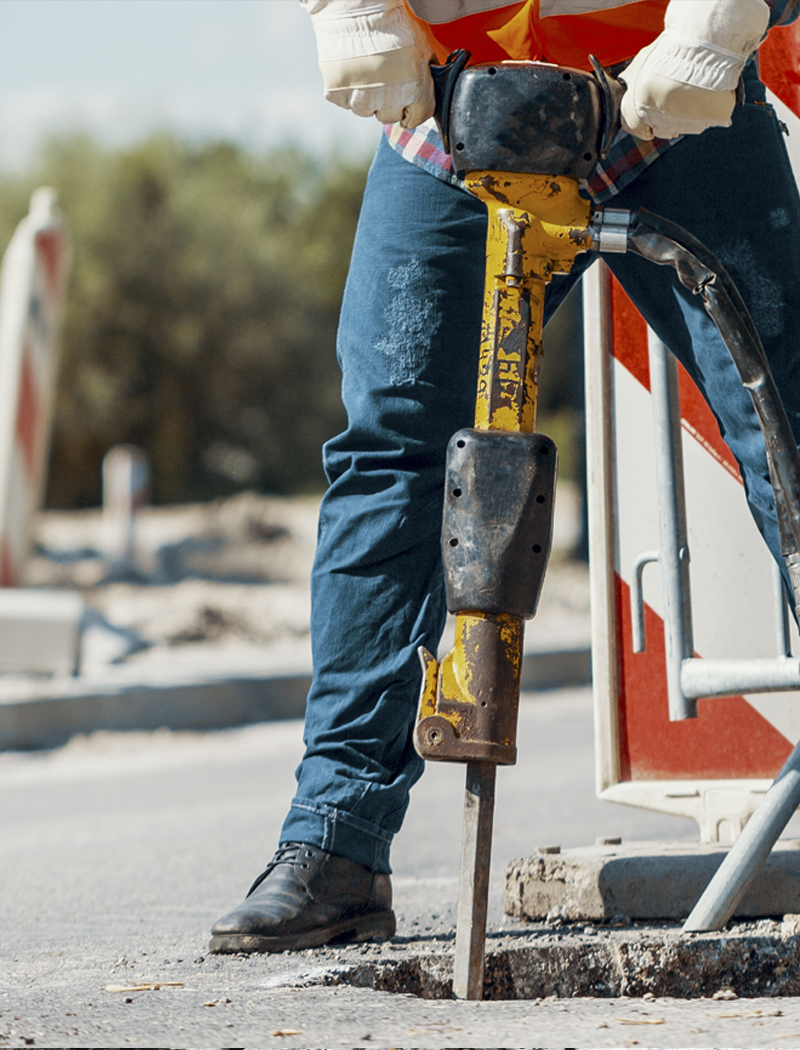
Shocking fact:
Not all utilities are members of 811. You are responsible for notifying non-member utilities.
Pipeline markers indicate the need for extra care around natural gas transmission pipelines and some distribution lines. These markers are usually found at roadways, railroad crossings, and other points along the pipeline route. For security purposes, pipeline markers do not show the exact location, path, depth, or number of natural gas pipelines in the area. In addition, pipelines may not follow a straight path between markers.
The markers provide a toll-free number for reporting problems 24 hours a day, 7 days a week. Call this number if you notice any unusual or suspicious activities nearby or if you see construction-related activity and no utility personnel are on-site.
Like pipeline markers, online maps indicate the approximate locations of major natural gas pipelines. To view these maps, visit the National Pipeline Mapping System website.
Pipeline markers and maps indicate only the general location of pipelines. Never use them as a substitute for notifying 811 to have all utility lines in your dig area located and marked.
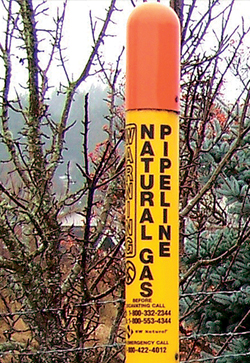
Shocking fact:
Most pipeline leaks are caused by accidental damage from excavation, construction, or farming activities.
Utility locator markings protect you. Make sure you and your crew know how to read utility locator markings and know the American Public Works Association (APWA) uniform color codes for marking underground utilities. Color code charts are usually available from your local 811 service.
Locator flags are placed within paint marks. If you find flags outside the borders of locator markings, someone may have tampered with them. Contact your local 811 utility locator service.
| APWA Color Code for Locator Marks | |
| Red | Electric power lines |
| Pink | Temporary survey markings |
| White | Proposed excavation |
| Yellow | Gas, oil, or steam |
| Blue | Potable water |
| Green | Sewers and drain lines |
| Orange | Communication lines, cables, or conduit |
| Purple | Reclaimed water, irrigation, and slurry lines |
Utility locator markings protect you from injury and prevent damage to underground utilities. Make sure you and your crew know how to read them.

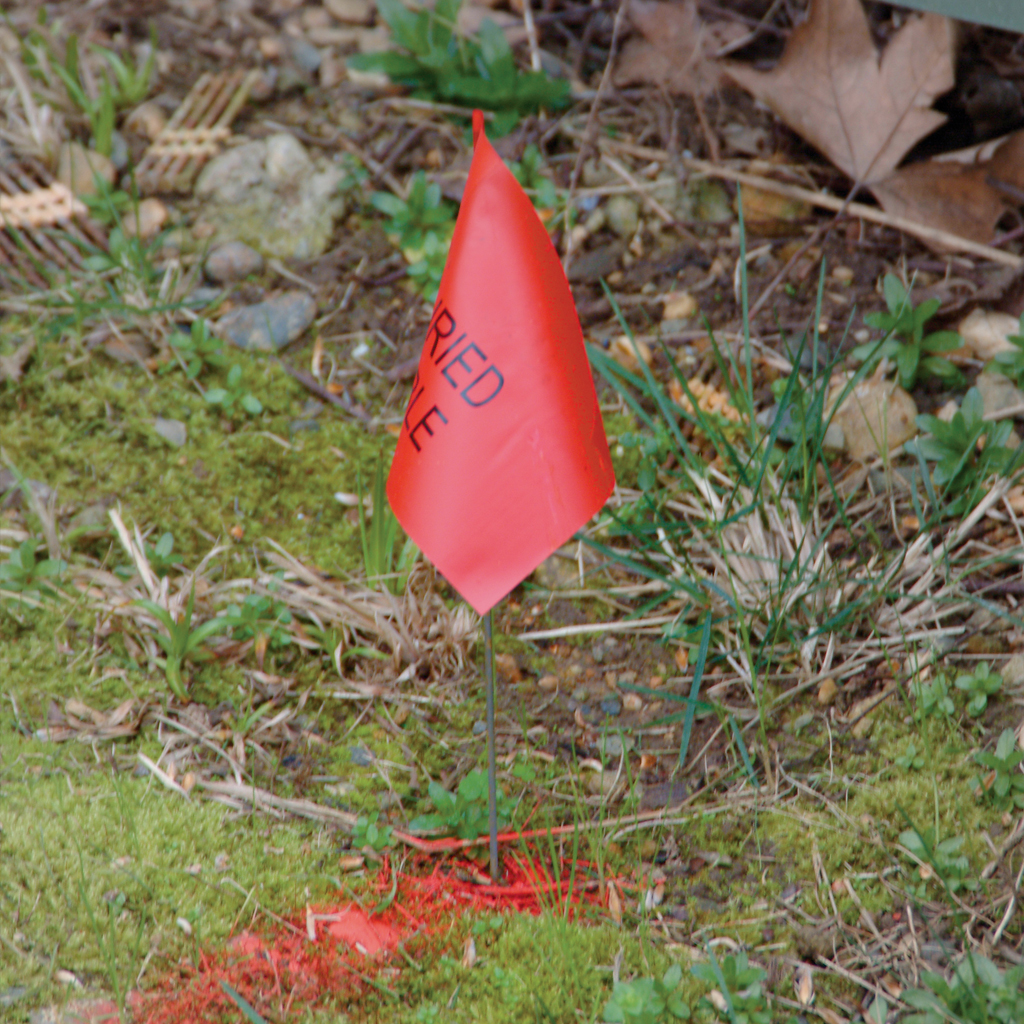
Shocking fact:
You might arrive at a job site and find no markers, even AFTER utility locating has been completed. In this case, do not assume that the area is clear of utilities. Someone may have pulled up the flags or rubbed out the markings. Or the locator may have marked the wrong site. Check for aboveground indicators that buried utilities may be present, such as utility meters and conduit. Contact the 811 service for assistance before starting work.
The tolerance zone protects buried utilities. The tolerance zone provides a buffer zone to prevent damage to underground utilities that could result from nearby excavation. The tolerance zone is the width of a marked underground utility line plus a specified distance on both sides of that utility: 24 inches in California. Hand dig prudently (or vacuum excavate) in the tolerance zone to determine the exact location and depth of marked utility lines. Do not use power-digging equipment within this zone.
The tolerance zone also protects you. If you do not respect the tolerance zone, you risk contacting buried utilities. You also risk damaging them indirectly by removing supporting soil, which could cause the utility to bend or break. You could be injured or killed, and your company could be liable for any damages that occur.
Always contact your state 811 center before digging and for the most current requirements.
To avoid utility damage, hand dig or use vacuum technology within the tolerance zone. Use a spotter to observe the excavation when heavy equipment is used near underground utility lines.
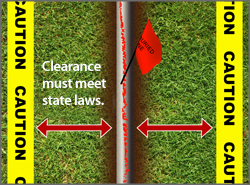
Shocking fact:
The width of the tolerance zone varies from state to state, and it is the excavator’s responsibility to know what it is.
Check utility depth for yourself. Before you can safely cross or work close to an underground utility, you must first verify its depth. Flags and locator marks tell you the direction the utility is running, but not how deeply it is buried. The only way to be sure of utility depth is to carefully expose it and see for yourself.
Proper hand-digging tools and techniques protect you and prevent utility line damage:
- Use a blunt-nosed shovel to loosen the soil and a regular shovel to remove it. Do not use a pickax or any sharp or pointed digging tools. Do not stab at the soil or stomp on the shovel with both feet.
- Work with a gentle prying action and dig at an angle so the shovel will slide along the surface of the wire, conduit, or pipe. Or, dig to the depth where you expect the utility line to be, but off to the side. Then use a prying motion to break away soil as you approach the utility laterally.
Use proper hand-digging tools and techniques to safely verify the depth of any buried utilities you must cross or work near.
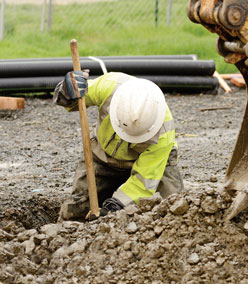
Shocking fact:
Buried utilities are supposed to be installed at a specified depth. But in reality, utility depth is unpredictable. Improper installation, landscaping, regrading, repaving, erosion, and building development can all alter utility depth.
Vacuum equipment saves hand labor. Vacuum technology can expose buried utilities without harming them. It uses suction and water pressure to remove soil down to the utility. Operate vacuum equipment only if you have been properly trained in its use.
If damage to a utility does occur, report it immediately. Repairs can be made more easily while the utility is still exposed. Never try to fix a damaged utility yourself.
Be sure to wear proper personal protective equipment when using vacuum technology to verify utility depth.
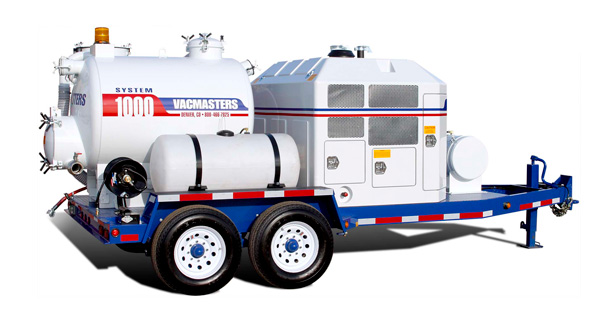
Shocking fact:
Follow recommended practices for backfilling any utilities you uncover or expose with vacuum technology. Check with the local utility owner and municipality. Some facilities require a bed of sand, fine stone, or slurry.
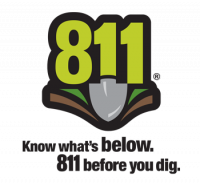 Notify 811 well in advance of directional drilling. If you are planning to use directional drilling, notify 811 well ahead of the job. Let them know about the equipment you will be using, and ask them to space locator marks closer together. This will help you see if the utility’s path shifts or turns suddenly.
Notify 811 well in advance of directional drilling. If you are planning to use directional drilling, notify 811 well ahead of the job. Let them know about the equipment you will be using, and ask them to space locator marks closer together. This will help you see if the utility’s path shifts or turns suddenly.
Dig potholes so you can safely monitor the drill head. A buried drill head makes it impossible to tell how close you really are to an existing utility. This makes it especially important to manually expose the line and watch as the drill string passes through. Consult with PG&E regarding the minimum clearance you must maintain between your boring equipment and any electric or natural gas lines. Use your potholes to watch the drill head cross utility lines during the initial bore and also during backreaming to ensure you maintain the required clearance.
Calibrate the bore head and locating device at the start of each job. Remember, your locating device will monitor the bore head on the pilot pass but may not be able to monitor the backream head. Plan accordingly if you have to expand the diameter of your bore before installation.
Pothole utilities so you can monitor the bore head path and visually verify a safe distance.

Shocking fact:
Many drilling rigs have utility strike alarms that will alert you if you contact a buried power line. If this alarm sounds, assume you have hit a live power line and follow your company’s guidelines and the emergency procedures described on this website.
There’s no such thing as minor damage to utilities. What looks like a small nick in a gas, sewer, electric, or water line can result in a major health and fire hazard to the surrounding neighborhood. And damaged phone lines or fiber optic cables can disrupt 911 emergency service.
Never bury a damaged utility. Trying to cover up an accident can be dangerous and can lead to costly damages or criminal charges against you and your company. Take the following steps instead.
If you contact a natural gas pipeline or suspect a gas leak, take these steps:
- Warn others and leave the area immediately.
- Do not use matches, lighters, or anything electrical—even a phone. A spark could ignite leaking gas.
- Do NOT attempt to stop the flow of gas or fix the pipeline. Leave the excavation open.
- When you have reached a safe distance away, report the incident:
- Call 911 immediately if you suspect a gas leak. Federal code requires this.
- Call PG&E at 1-800-743-5000 in California or your local gas utility if you suspect a gas leak or contact a pipeline, even if damage is not apparent.
- Stay far away and upwind from the area until safety officials say it is safe to return.
- Report the incident to your supervisor.
If you are operating equipment that contacts a power line, take these steps:
- Move the equipment away from the line if you can do so safely.
- Remain on the equipment until utility workers say it is safe to get off.
- Warn others to stay away from the line and anything it is touching. Anyone who touches the line, the equipment, or even the ground nearby may be injured or killed.
- Have someone call 911 and PG&E at 1-800-743-5000 immediately.
- If fire or other danger forces you off:
- Do NOT touch the equipment and the ground at the same time.
- Jump clear and land with your feet together.
- Shuffle away with small steps or hop away on two feet, keeping both feet close together at all times.
- Do not return to the equipment until utility personnel tell you it is safe.
In the event of any type of utility contact, take appropriate safety steps and notify your supervisor and the utility immediately.
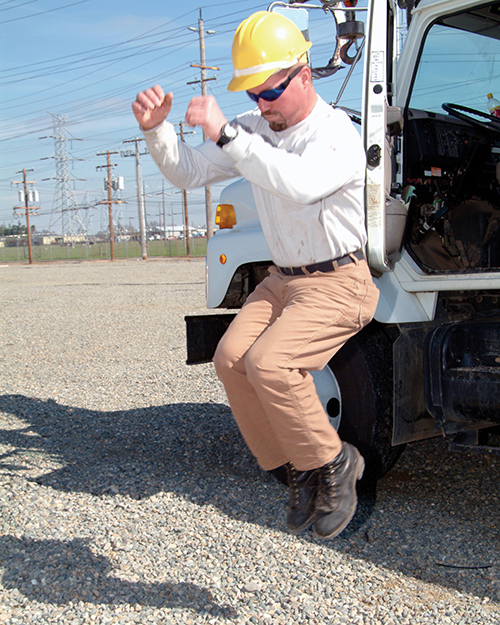
Learn the warning signs of a gas pipeline leak.
PG&E puts the safety additive mercaptan in natural gas, giving it a distinctive odor and making it easier to detect. Don’t rely on your nose alone. Some gas leaks are also detectable by sight or sound. Signs of a gas leak include:
- A distinctive, sulfur-like or rotten-egg odor
- Continuous bubbling in water
- A hissing, whistling, or roaring sound
- Dead or dying vegetation (in an otherwise moist area) over or near a pipeline
- Dirt blowing into the air from a hole in the ground
- An exposed pipeline after an earthquake, fire, flood, or other disaster
- A damaged connection to a gas appliance
If you observe any of the above conditions, call 911 and the PG&E emergency phone number at 1-800-743-5000 or your local gas utility.
